Cleanroom Technology Market Size
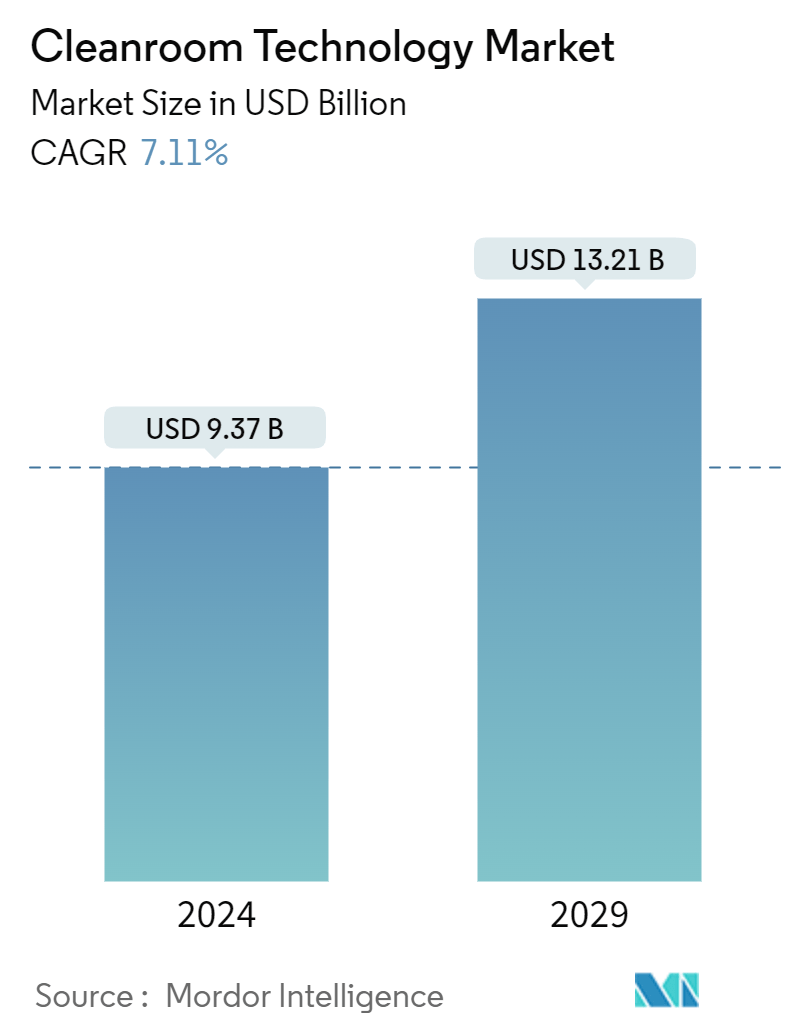
| Study Period | 2019 - 2029 |
| Market Size (2024) | USD 9.37 Billion |
| Market Size (2029) | USD 13.21 Billion |
| CAGR (2024 - 2029) | 7.11 % |
| Fastest Growing Market | Asia Pacific |
| Largest Market | North America |
Major Players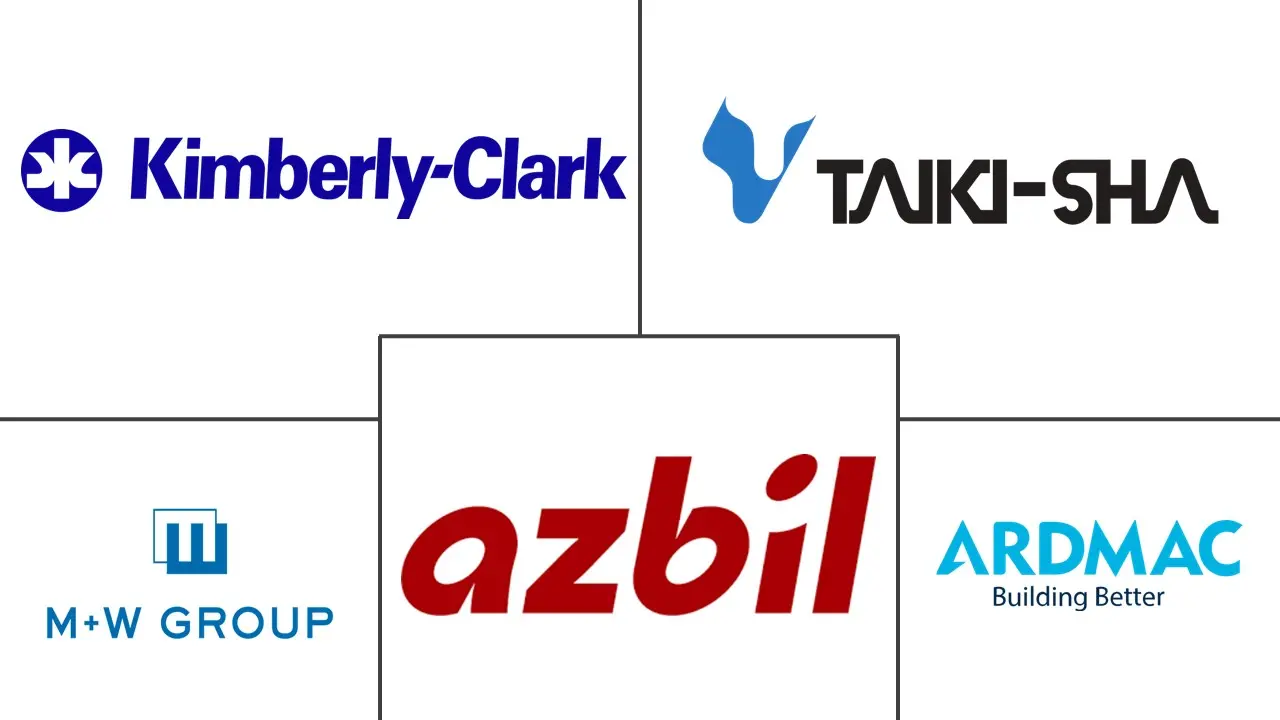
*Disclaimer: Major Players sorted in no particular order |
Need a report that reflects how COVID-19 has impacted this market and its growth?
Cleanroom Technology Market Analysis
The Cleanroom Technology Market size is estimated at USD 9.37 billion in 2024, and is expected to reach USD 13.21 billion by 2029, growing at a CAGR of 7.11% during the forecast period (2024-2029).
- The demand for cleanroom technology grows as quality and safety standards evolve and become more stringent. Cleanrooms offer controlled environments with precise regulation of air quality, particulate levels, temperature, and humidity. They minimize the risk of contamination from airborne particles, microorganisms, and other contaminants that can adversely affect product integrity. Industries such as pharmaceuticals, biotechnology, and electronics rely on cleanrooms to meet the strict quality and safety requirements imposed by regulatory bodies. The increasing focus on quality and safety standards drives the adoption of cleanroom technology to maintain and ensure significant product quality and safety standards.
- The modern, clean room development began during the Second World War to enhance the quality and reliability of instrumentation used in manufacturing tanks, guns, and aircraft. During this time, HEPA filters were also developed to contain the dangerous radioactive, microbial, or chemical contaminants that resulted from experiments into nuclear fission and research into chemical and biological warfare. The evolution of clean rooms gained momentum due to NASA's space travel program in the 1950s and 1960s. During this time, the 'laminar flow' concept was introduced, marking a turning point in clean room technology.
- With the growing demand for electronics, cleanroom technology providers are witnessing increased business. As a result of this, governments from developed and developing nations are significantly working toward securing ample cleanrooms to handle any scarce situation domestically. For instance, the US government officially passed the CHIPS Act in the previous year. Under this act, the US government wanted US companies to build cleanrooms in the United States for semiconductor manufacturing instead of outsourcing to cleanrooms in foreign countries. After introducing this act, foreign semiconductor manufacturers have also been planning new US-based cleanrooms to get US government funding.
- In April 2024, President Biden announced up to USD 6.1 billion preliminary agreement with Micron under the CHIPS and Science Act. This investment will support the construction of two fabs in Clay, New York, and one fab in Idaho, releasing USD 50 billion in private investment by 2030 as the first step toward Micron's investment of up to USD 125 billion across both states over the next two decades to create a leading-edge memory manufacturing ecosystem. Funding will support the construction of the first two fabs of a planned four-fab "megafan" focused on leading-edge DRAM chip production. Each fab will have 600,000 square feet of cleanrooms, totaling 2.4 million square feet of cleanroom space across the four facilities, the most extensive cleanroom space ever announced in the United States and the size of nearly 40 football fields.
- Growing demand for medical instruments and increasing R&D spending in the pharmaceutical industry further propel the market growth. According to IQVIA, the global pharmaceutical market has experienced significant growth in recent years. In 2023, the total global pharmaceutical market was around USD 1.6 trillion. This is an increase of over USD 100 billion compared to the previous year.
- The demand for cleanroom technology grows as quality and safety standards evolve and become more stringent. Cleanrooms offer controlled environments with precise regulation of air quality, particulate levels, temperature, and humidity. They minimize the risk of contamination from airborne particles, microorganisms, and other contaminants that can adversely affect product integrity. Industries such as pharmaceuticals, biotechnology, and electronics rely on cleanrooms to meet the strict quality and safety requirements imposed by regulatory bodies. The increasing focus on quality and safety standards drives the adoption of cleanroom technology to maintain and ensure significant product quality and safety standards.
- For instance, in August 2023, Bosch announced plans to establish a state-of-the-art semiconductor test center for chips and sensors in Malaysia. The facility boasts an expansive area of over 18,000 square meters, housing clean rooms, office spaces, and dedicated R&D laboratories to accommodate up to 400 associates.
- Cleanrooms are gaining popularity in various end-user markets as a controlled environment is necessary for maintaining high-quality products. However, the cost of a cleanroom is not only highly investment-intensive to build, but operational costs can also rely on the number of required air exchanges and filtration efficiency. The operation can be extremely costly, as holding the appropriate air quality means the room has to be in constant operation. Energy-efficient operation and continuous adherence to cleanroom standards make a cleanroom one of the most critical infrastructures for manufacturing technology and laboratories. This is anticipated to challenge the market's growth.
- The war between Ukraine and Russia potentially disrupts the global supply chain for cleanroom technology components. Ukraine is a significant producer of semiconductor-grade silicon, a crucial material for manufacturing semiconductor chips used in cleanroom technology. Any disruption in the supply of these materials could lead to shortages and price gains for cleanroom technology products worldwide. Additionally, geopolitical tensions may also impact international trade routes and regulations, further affecting the availability of cleanroom technology components. In addition, many of the world's largest fabricators, like Intel and the Taiwan Semiconductor Manufacturing Company (TSMC), are expanding capacity with new fabrication facilities to satisfy that demand, positively impacting the market.
Cleanroom Technology Market Trends
Semiconductor Manufacturing End User Significantly Driving the Market Growth
- Cleanrooms are necessary for semiconductor manufacturing as this industry relies heavily on cleanroom environments to manufacture sensitive microelectronics. Semiconductor chips are utilized in every computerized device, from household objects like cell phones to complex machines such as vehicles, defense technology, or spacecraft. They are produced using susceptible materials to create delicate layers that must be worked on carefully. Thus, tasks like semiconductor chip manufacturing, packaging, and testing must be carried out in a controlled cleanroom environment.
- Semiconductor cleanrooms are among the most demanding cleanrooms. As photolithography linewidths go below 0.1 microns, these cleanrooms are usually class 10 or 100 cleanroom classification (ISO-4 or ISO-5). Additionally, semiconductor cleanrooms have tight temperature and humidity requirements. Such cleanrooms can vary in size from 500 SF to 500,000 SF; usually, semiconductor cleanrooms use ULPA filters instead of HEPA filters to prevent even the smallest submicron particles from entering the cleanroom. While HEPA filters can catch 99.97% of particles at 0.3u, ULPA filters can catch 99.999% at 0.12u.
- For instance, in June 2023, Micron Technology Inc., one of the world’s significant semiconductor companies, announced plans to build a unique assembly and test facility in Gujarat, India. Micron’s new facility will allow assembly and test manufacturing for DRAM and NAND products and address demand from domestic and international markets.
- The growing investments in the semiconductor industry worldwide are a key growth driver for the market. For instance, in July 2023, Analog Devices Inc. announced its intention to enhance its cleanroom capabilities to optimize manufacturing. The company will introduce a semiconductor maintenance training program as part of its latest investment. This substantial investment of USD 1 billion is poised to foster the growth and efficiency of the semiconductor facility in Beaverton. Notably, the expansion will result in an additional 25,000 square feet, boosting the cleanroom capacity to an impressive 118,000 square feet.
- Recently, Morgan State University secured an additional USD 6.8 million in state funding to support the launch of two latest research centers that will create and drive innovation in the design and fabrication of semiconductors and handle the challenges facing public school education.
- As the demand for semiconductors rises, driven by trends such as the expansion of 5G networks, the proliferation of Internet of Things (IoT) devices, and the growth of artificial intelligence (AI) and machine learning (ML) applications, semiconductor manufacturers need to ramp up production capacity. This increased production capacity requires constructing or expanding cleanroom facilities equipped with the latest cleanroom technology to meet the stringent cleanliness standards necessary for semiconductor fabrication. According to WSTS, 2024 semiconductor sales were expected to reach USD 588.36 billion worldwide, significantly more than the previous year.
- Overall, the growing demand for semiconductors drives investment in cleanroom technology to support the expansion of semiconductor manufacturing capacity and ensure the production of high-quality chips for various industries and applications.
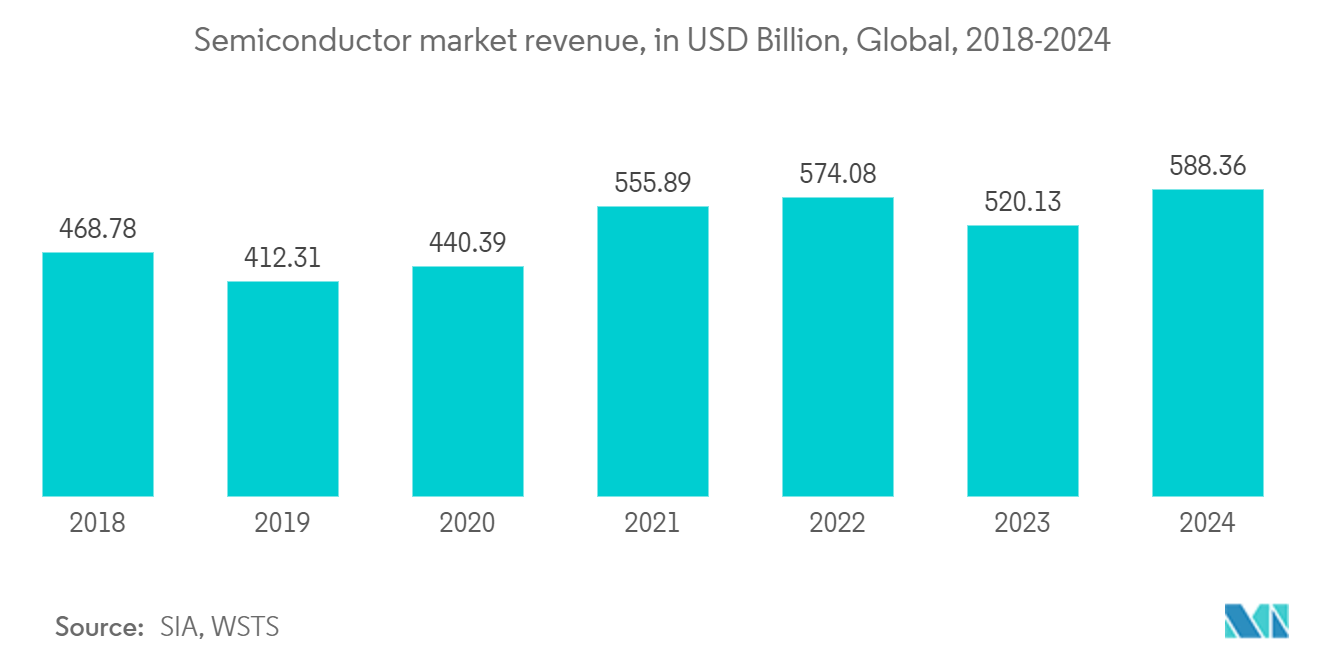
North America is Expected to Hold Significant Market Share
- It is anticipated that North America will experience significant growth during the forecast period, primarily due to the technological advancements in cleanrooms, the growth of the healthcare sector in the region, and stringent regulatory standards for product approvals are the factors propelling the development of this market. According to CMS, the total US national health expenditure recorded was USD 4.8 trillion in FY 2024, and it is projected to reach USD 7.1 trillion by 2031.
- Rising aftermarket sales and the shift toward modified cut-to-length logging techniques also contribute to the market growth. This growth is primarily attributed to the growing biotechnology industry, which is still young, especially compared with the automotive, chemical, and steel industries. The development of the biotechnology industry is a unique story, and yet it rests on foundations common to other segments of American industry. According to NIH, biotechnology funding by the NIH was around USD 8.9 billion during the fiscal year 2023. Further, it is estimated to reach USD 9.1 billion by FY 2024.
- Years of research, both government-funded and privately funded, continue to provide a knowledge base unequaled in the world. Through biomanufacturing, sustainable biomass across the United States has been converted into new products and provides an alternative to petroleum-based production for chemicals, medicines, fuels, materials, and more.
- For instance, the Financial Times US Pharma and Biotech Summit returned to New York in May 2024, partnering with Endpoints News for the first time. The event gathered biopharma leaders, regulators, investors, and scientists to share unique insights about the year ahead and discuss the most critical trends affecting the industry and the country. Such initiatives may further propel the market demand in the region.
- In April 2024, Amgen opened a new AI-enabled biomanufacturing facility in New Albany, Ohio. It will employ roughly 400 people. The USD 365 million investment features automation, AI, and data-driven manufacturing processes, optimizing real-time performance. The facility was built with environmental sustainability standards, supporting Amgen’s carbon neutrality goals.
- The regional countries are mainly looking forward to strengthening chip manufacturing, which is expected to help America with the strategic technologies of the future, including AI, 5G, and quantum computing, that will determine global economic and military leadership for decades to come. According to a new report by the Semiconductor Industry Association, the US government has a strategic opportunity to reverse the decades-long trajectory of declining chip manufacturing in America, strengthen national security, make supply chains more resilient, and make the country one of the most attractive places in the world to produce semiconductors. This growth is expected to provide a vast share of traction to the North American cleanroom technology market as the companies have announced their plans to majorize the region in the upcoming few years.
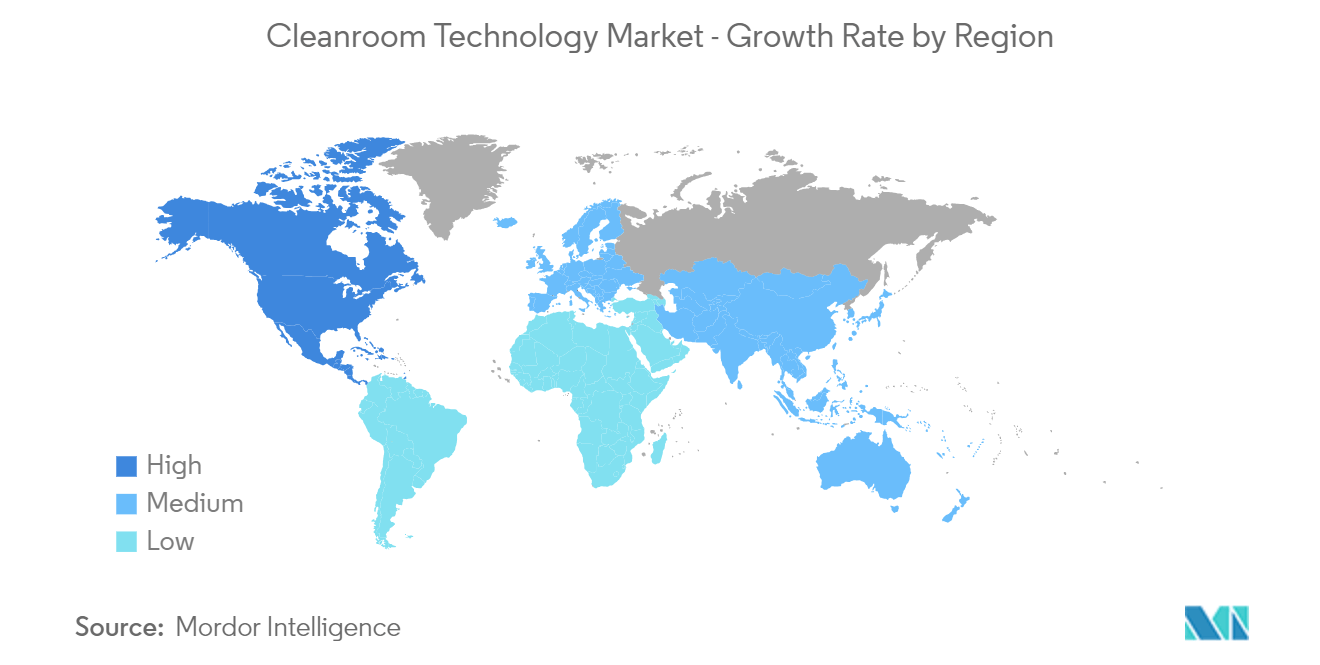
Cleanroom Technology Industry Overview
In the cleanroom technology market, intense competitive rivalry prevails due to the fragmentation of the cleanroom equipment industry, with numerous vendors vying for market share. Fierce competition is evident among these vendors, especially in the consumable segments, as they seek to capture a larger portion of the market. Key players in this sector include M+W Group GmbH, Azbil Corporation, Taikisha Global Limited, Kimberly Clark Corporation, and Ardmac Ltd.
April 2024: AES Clean Technology announced the launch of its CleanLock Module at INTERPHEX 2024 on April 16, 2024. The airlock solution for cleanrooms is engineered to minimize the risk of contamination by integrating AES’ proprietary cleanroom finishes, patented lighting, predictable airflow patterns, and advanced door controls. These features can be incorporated into any facility without delay. The CleanLock Module allows for a secure transition of people and materials entering existing cleanrooms.
February 2024: Analog Devices Inc. announced that the company made a special arrangement with TSMC, the world's significant dedicated semiconductor foundry, to supply long-term wafer capacity through Japan Advanced Semiconductor Manufacturing Inc. ("JASM"), TSMC's majority-owned manufacturing subsidiary in Kumamoto Prefecture, Japan.
Cleanroom Technology Market Leaders
M+W Group
Azbil Corporation
Taikisha Global Limited
Kimberly Clark Corporation
Ardmac Ltd
*Disclaimer: Major Players sorted in no particular order
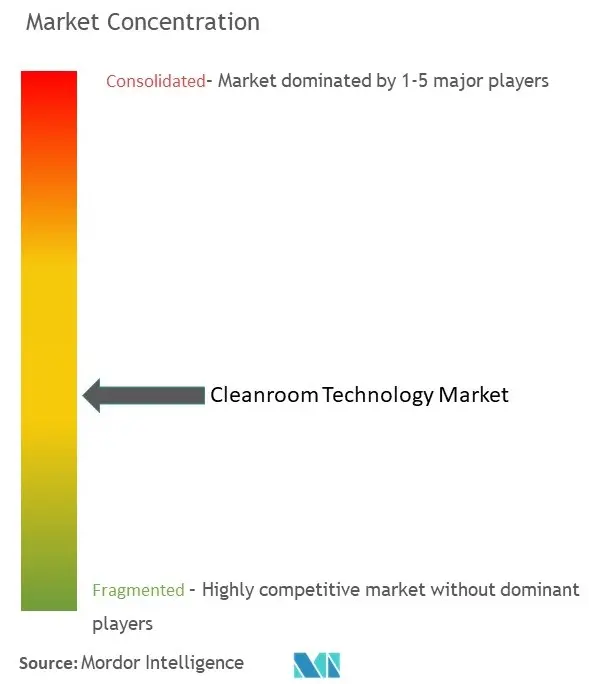
Cleanroom Technology Market News
- May 2024: The Cleanroom Technology Conference in the United Kingdom addressed topics ranging from standards and regulations to operational aspects of cleanrooms in pharma and semiconductor manufacturing by the end of May. This two-day event at the National Conference Centre is an excellent opportunity to meet industry professionals and experts to discuss, network, and source products and knowledge for their cleanroom and contamination control processes.
- April 2024: UV Medico announced its presence at the Lounges Cleanroom Trade Show from April 23 to 25. It took place in Karlsruhe, Germany. This trade show focused explicitly on cleanroom technology, one of the primary areas of expertise for UV Medico.
- March 2024: The Biden administration reached an agreement to provide Intel with up to USD 8.5 billion in direct funding and USD 11 billion in loans for computer chip plants in four states, a cash infusion that the government says should help the United States boost its global share of advanced chip production from zero to 20%. Intel employees in clean room "bunny suits" work at Intel's D1X factory in Hillsboro, Oregon. The company plans to modernize operations in Oregon with the help of federal funding from the Biden administration.
Cleanroom Technology Market Report - Table of Contents
1. INTRODUCTION
1.1 Study Assumptions and Market Definition
1.2 Scope of the Study
2. RESEARCH METHODOLOGY
3. EXECUTIVE SUMMARY
4. MARKET INSIGHTS
4.1 Market Overview
4.2 Industry Attractiveness - Porter's Five Forces Analysis
4.2.1 Bargaining Power of Suppliers
4.2.2 Bargaining Power of Buyers
4.2.3 Threat of New Entrants
4.2.4 Threat of Substitutes
4.2.5 Degree of Competition
4.3 Impact of Key Macroeconomic Trends on the Market
5. MARKET DYNAMICS
5.1 Market Drivers
5.1.1 Overall Growth in Biotechnology and Healthcare Spending in Major Markets
5.1.2 Stringent Government Regulations and Demand for Quality Products
5.2 Market Challenges
5.2.1 High Installation, Maintenance Costs, and Lack of Skilled Workforce
6. MARKET SEGMENTATION
6.1 By Component
6.1.1 Type of Equipment
6.1.1.1 Cleanroom Air Showers
6.1.1.2 HVAC Systems
6.1.1.3 Laminar Air Flow Systems
6.1.1.4 High Efficiency Filters
6.1.1.5 Desiccator Cabinets
6.1.1.6 Fan Filter Units
6.1.2 Type of Consumable
6.1.2.1 Apparels
6.1.2.2 Gloves
6.1.2.3 Wipes
6.1.2.4 Vacuum Systems
6.1.2.5 Disinfectants
6.1.2.6 Other Types of Consumables
6.2 By End User
6.2.1 Pharmaceutical
6.2.2 Biotechnology
6.2.3 Medical Devices
6.2.4 Hospitals
6.2.5 Semiconductor Manufacturing
6.2.6 Other End Users
6.3 By Geography
6.3.1 North America
6.3.2 Europe
6.3.3 Asia-Pacific
6.3.4 Rest of the World (Latin America and Middle East and Africa)
7. COMPETITIVE LANDSCAPE
7.1 Company Profiles
7.1.1 M+W Group
7.1.2 Azbil Corporation
7.1.3 Taikisha Global Limited
7.1.4 Kimberly Clark Corporation
7.1.5 Ardmac Ltd
7.1.6 Ansell Limited
7.1.7 Clean Air Products
7.1.8 Labconco Corporation
- *List Not Exhaustive
8. INVESTMENT ANALYSIS
9. FUTURE OF THE MARKET
Cleanroom Technology Industry Segmentation
A cleanroom is a controlled environment that filters pollutants like airborne microbes, dust, and aerosol particles to deliver the cleanest area possible. In a controlled environment with minimal particulate contamination, specific temperature, humidity, room pressure, and particle and dust count are achieved and maintained using cleanroom equipment, specialized partitions, cleanroom walls, ceilings, and flooring systems. Consumables like apparel, gloves, wipes, vacuum systems, disinfectants, and sanitizers are used.
The cleanroom technology market is segmented by component (type of equipment {cleanroom air showers, HVAC systems, laminar airflow systems, high-efficiency filters, desiccator cabinets, and fan filter units}, type of consumable {apparel, gloves, wipes, vacuum systems, disinfectants, and other type of consumables}), end users (pharmaceutical, biotechnology, medical devices, hospitals, semiconductor manufacturing, and other end users), and geography (North America, Europe, Asia-Pacific, Latin America, Middle East and Africa, and Rest of the World). The market sizes and predictions are provided in terms of value in USD for all the above segments.
| By Component | ||||||||
| ||||||||
|
| By End User | |
| Pharmaceutical | |
| Biotechnology | |
| Medical Devices | |
| Hospitals | |
| Semiconductor Manufacturing | |
| Other End Users |
| By Geography | |
| North America | |
| Europe | |
| Asia-Pacific | |
| Rest of the World (Latin America and Middle East and Africa) |
Cleanroom Technology Market Research FAQs
How big is the Cleanroom Technology Market?
The Cleanroom Technology Market size is expected to reach USD 9.37 billion in 2024 and grow at a CAGR of 7.11% to reach USD 13.21 billion by 2029.
What is the current Cleanroom Technology Market size?
In 2024, the Cleanroom Technology Market size is expected to reach USD 9.37 billion.
Who are the key players in Cleanroom Technology Market?
M+W Group, Azbil Corporation, Taikisha Global Limited, Kimberly Clark Corporation and Ardmac Ltd are the major companies operating in the Cleanroom Technology Market.
Which is the fastest growing region in Cleanroom Technology Market?
Asia Pacific is estimated to grow at the highest CAGR over the forecast period (2024-2029).
Which region has the biggest share in Cleanroom Technology Market?
In 2024, the North America accounts for the largest market share in Cleanroom Technology Market.
What years does this Cleanroom Technology Market cover, and what was the market size in 2023?
In 2023, the Cleanroom Technology Market size was estimated at USD 8.70 billion. The report covers the Cleanroom Technology Market historical market size for years: 2019, 2020, 2021, 2022 and 2023. The report also forecasts the Cleanroom Technology Market size for years: 2024, 2025, 2026, 2027, 2028 and 2029.
What are the emerging Cleanroom Technologies impacting the market?
The emerging Cleanroom Technologies that are impacting the market are a) Innovations like self-disinfecting surfaces b) Automated monitoring systems c) Advancements in air filtration technologies
What are the emerging Cleanroom Technologies impacting the market?
The emerging Cleanroom Technologies that are impacting the market are a) Innovations like self-disinfecting surfaces b) Automated monitoring systems c) Advancements in air filtration technologies
Cleanroom Technology Industry Report
The cleanroom industry is on an upward trajectory, fueled by the growing need for contamination control in sectors like healthcare, pharmaceuticals, biotechnology, and semiconductor manufacturing. This surge is backed by stringent global regulatory standards, pushing companies towards adopting advanced cleanroom technologies to ensure product safety and quality. Innovations in the field are making cleanroom solutions more adaptable and efficient, tailored to the diverse requirements of various industries. The expansion of the biologics sector, increased demand for medical devices, and higher research and development investments in pharmaceuticals are key drivers of this market growth. Moreover, the rising interest from developing economies offers cleanroom companies significant expansion opportunities. Despite the challenges in customizing cleanroom designs, the industry's ability to innovate underscores its crucial role in maintaining high-quality manufacturing standards, especially in healthcare, to safeguard patient safety and product efficacy. According to Mordor Intelligence™ Industry Reports, the cleanroom technology market is experiencing robust growth, with detailed analysis available, including market share, size, revenue growth rate, and a forecast outlook, available as a free report PDF download.
